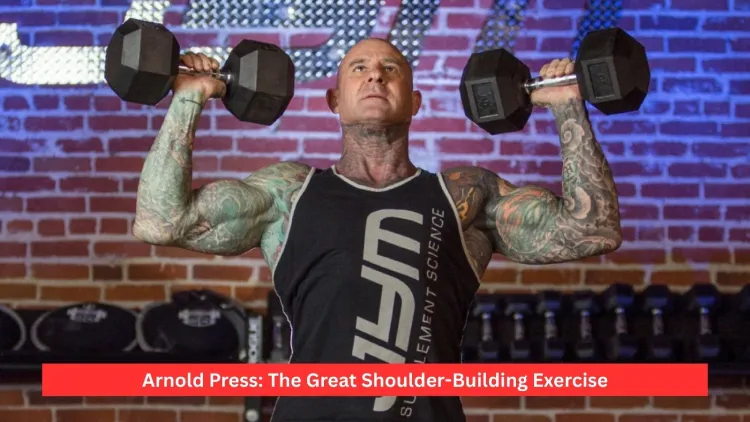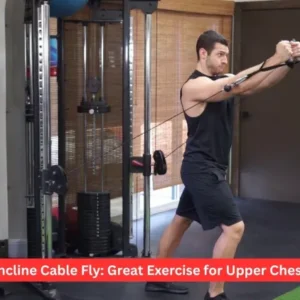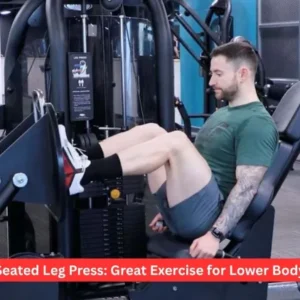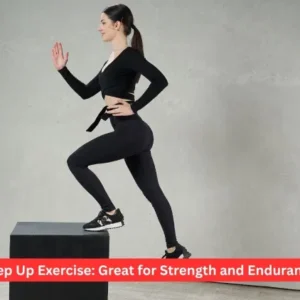Arnold Press is a popular exercise to do when one is keen on having strong and well-shaped shoulders. The combination of rotation and pressing involves more muscle fibres in comparison to a traditional shoulder press. This suits it to the ones that desire bigger and rounder shoulders, better posture and performance in athletics. This exercise can be the key to your program, whether you are a beginner in your fitness regime or you are an advanced lifter who needs variety.
What Is the Arnold Press?
In essence, the Arnold press is a twist on the dumbbell-based overhead squat. You start by having the dumbbells at a level with your chest, but with the palms facing and the elbows close in front. When lifting, you roll your hands such that at the apex, your palms are facing evenly at the middle. This muscle force is ideal, and it maximises the recruitment of the muscles in the deltoids and stabilising muscles.
The Arnold Press is effective due to its rotation:
- The front (anterior) deltoids are responsible for the power and flexion of the shoulder.
- Shoulder width and roundness (shoulder): side deltoids.
- To maintain stability in the shoulders, the rear (posterior) deltoids are involved.
- Posture aids- Trapezius muscles and upper back.
- Triceps as secondary movers.
- Slight even of the chest upper part, because of the inward start point.
It is assumed to be among the exercises that indeed engage the three shoulder heads at the same time, which is why it is a staple among lifters of hypertrophy.
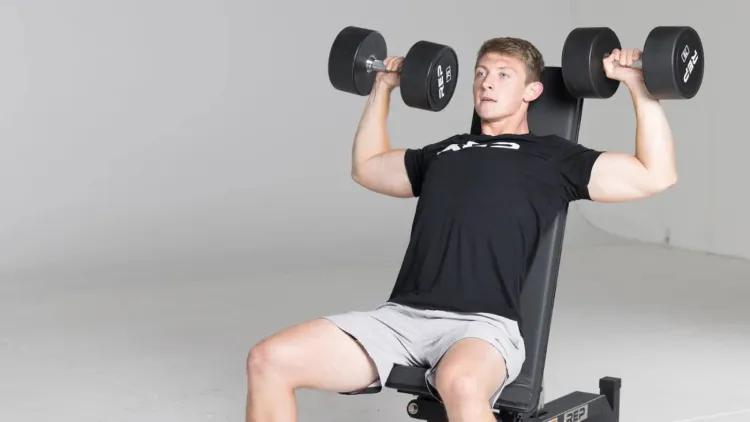
How to Perform the Arnold Press Correctly
Starting Position:
- Add a back support to a bench and sit on it (or stand on your feet, with your shoulders level apart, feet as wide as they can be stable) to use your core.
- Place a dumbbell in both hands, with the elbows bent upward, the palms against the torso, the dumbbells at what can most encourage.
Execution:
- Breath deeply, and then lift.
- Keep pressing the dumbbells upwards and with your palms forward at the same time, turn them outward till they become facing upwards on top.
- Use your wrists on top of your elbows to align them.
Lowering Phase:
- Using inhaling to slowly push yourself backwards, turning palms towards your own torso and back to the initial position.
Breathing Technique:
- Breathe out in case of pressing (lifting).
- Breathe in during the lowering phase to reestablish. This type of breathing only makes your core firm and your spine strong.
Hint: Concentrate on control and not speed. Quality repetitions cause more muscles to build and decrease shoulder injury.

Benefits of the Arnold Press
- Full Shoulder Activation- The rotation uses all three heads of the deltoid, making it more efficient than any shoulder press as a whole development.
- Better Movement: The movement facilitates a shoulder joint that becomes flexible and reduces the risks of injury.
- Hypertrophic-Friendly: It causes a great number of muscle fibres to develop, so it is excellent for muscle development.
- Developing Stability and Core: Standing exercises will create core involvement, increase balance and functional strength.
- Posture Enhancement: The rear delts, the traps are strengthened to counteract slouch and forward-rounded shoulders.
Arnold Press vs. Other Shoulder Press Variations
The question asked by numerous lifters is whether the Arnold Press is more advantageous than the shoulder or military press, which is traditional. Even though classic overheads, the overhead press is a good exercise to use to build brute strength; it does not involve much of the rear delts, nor differs greatly in working other regions. The rotation demonstrated by the Arnold Press incorporates the rear delts, which is why it makes it better regarding aesthetics.
Arnold Press is usually viewed as an improvement in case you want to hypertrophy and develop the fullness of your shoulders. To achieve the greatest overhead strength, the strict military press still remains the top choice as it can be light or heavy loaded and is stable.
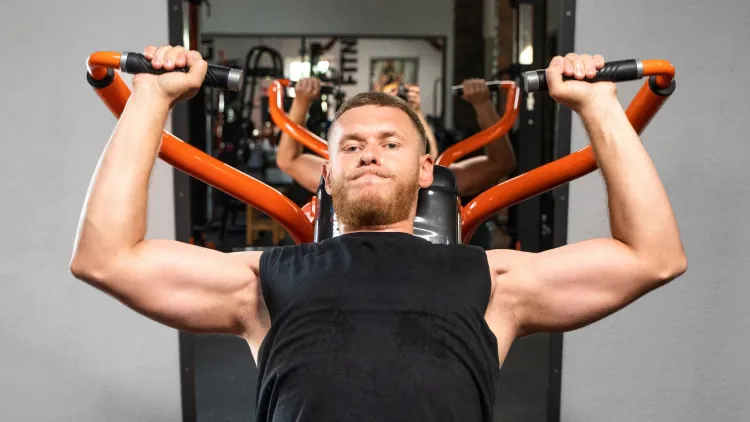
Choosing the Right Arnold Press Weight
How much would Arnold Press? It depends on your level:
- Beginners: This activity must start with 5-10 kg of dumbbells to familiarise oneself with the action.
- Intermediate lifters: Dumbbells with a mass of 1220kg regularly offer a sufficient challenge to development.
- Advanced lifters: Find a weight which you can perform with 12 controlled reps at a time, or get an 8 with a steady performance without bulging form.
Manageable weights and more reps with higher frequencies (8- 15) are effective with hypertrophy. In case the repetition of the shoulder press is not as strong as other exercises, you need to dwell on progressive overload, and make sure to train the supporting muscles, such as traps, triceps.
How Often to Include the Arnold Press
Shoulders are also faster in their recovery over bigger muscle groups. According to their program, most lifters may add the Arnold Press 12 times a week. In most cases, use it together with lateral branches to have partially opposite angles like row uprights or face pulls.
In case you already do the heavy bench or military pressing, maintain the medium volume in order not to overstrain your shoulder joints.
Common Mistakes to Avoid
- Excessive Use of weight: Being heavy does not necessarily help. A large load may result in flaring or arching elbows.
- Rushing The Movement: Fast reps increase the duration that you spend in tension and which limits growth and makes the body more susceptible to injury.
- Lack of Spectrum of Movement: Halfway lowering the dumbbells no longer provides the option of the initial advantage of the exercise.
- Overlook of Warm-Ups: Warm-Ups, Cold shoulders: warm up by making dynamic stretches or doing light sideways lifts.
- Arching the Lower Back: Investigating when standing. Use the back bench or a seated bench.

Variations of the Arnold Press
- Arnold Sitting Press: Seated position. This gives you more stability, which gives you the opportunity to add a little more weight.
- Standing Arnold Press: Grabs the midsection of the body and enhances athletics.
- Single-Arm Arnold Press: Ideal for remedying of imbalance between the shoulders.
- Slow-Tempo Arnold Press: The longer the time under tension used, the greater the hypertrophy.
The Arnold Press and Muscle Growth
The Arnold Press recruits all the heads of the deltoid plus stabilising muscles; therefore, making it the best exercise in terms of hypertrophy. Nevertheless, it is not the sole shoulder exercise to perform. Complement it with:
- Lateral pull-ups to ignore lower delts.
- Razor cut pulls to strike on the back, rear, and upper back.
- Maximum full speed overhead presses, or push presses.
Multi-angled method is used to construct traps and shoulders quickly and minimises the weak, which is reduced.
Safety Tips and Shoulder Health
- There should never be heavy dumbbells or resistance bands used.
- All reps should be slow, and controlled momentum diminishes.
- It is impolite to lock your elbows on the top; there must be a slight tension.
- In case of joint pain (not fatigue in the muscles), cease and examine the shape or decrease the weight.
It is likely to have weak shoulders or heavy overhead pressing. Giving proper load, that is necessary, such as strengthening stabiliser muscles, increasing mobility, and overloading your lifts progressively, will overcome this problem.
Sample Arnold Press Shoulder Workout
| Exercise | Sets | Reps | Notes |
| Seated Arnold Press | 3–4 | 8–12 | Focus on controlled rotation |
| Lateral Raises | 3 | 12–15 | Isolate side delts for width |
| Upright Rows or Face Pulls | 3 | 10–12 | Build traps and rear delts |
| Push-Ups or Bench Press | 2–3 | 12–15 | Complement pressing strength |
You can add pull-ups or lat pulldowns to target your lats for a balanced upper body.
Advanced Tips for Bigger Shoulders and Traps
- Progressive Overload: Add either dumbbell weight or better reps slowly in order to stimulate progress.
- Attention Technique: It is best to invest in technique rather than go heavy.
- Train Supporting Muscles: Triceps and traps are strong and which help improve the pressing performance.
- Nutrition and Recovery: Nutrition is necessary, including adequate protein, sleep and rest days, which are vital in hypertrophy.
- SP Switch between Heavy and Light Days: And alternate high rep moderate, and heavy mechanisms that will recruit muscle fibres optimally.

Final Thoughts
Arnold Press is not necessarily another shoulder-pressing exercise; rather, it is a proven technique of growing a balanced, strong, and nice set of shoulders. When the rotation is introduced in a normal press, it stimulates all three heads of the deltoid, enhances movement as well and helps develop hypertrophy. Some people can move 10 kg or 30 kg dumbbells, but the point is that it should be correctly positioned, gradually increasing in load, and supported by other works, such as lateral lifts or face pays and bench movements, to make it a well-balanced program.
Do it regularly and the Arnold Press will see you come out of plateaus, improve weaknesses and build up those types of upper-body strength and shape that are noticeable. You want to go light at the beginning, concentrate on the technique, and gradually accumulate your weights. You will quickly understand why Arnold Schwarzenegger had this exercise as part of his regular training.
Frequently Asked Questions
1. What muscles work with the Arnold Press?
The Arnold Press also activates the traps, triceps, and the upper chest in addition to all three heads of the deltoids, in front, side, and back. Its movement also gives it a rotational form and enables complete muscle involvement, unlike a regular shoulder press, which makes it one of the most comprehensive shoulder exercises.
2. What is the weight that I should put on the Arnold Press?
New learners ought to use dumbbells weighing 5 to 10 kg to get used to the form. Middle-level lifters frequently resort to the weight of 12-20 kg, whereas advanced lifters select an amount of weight that will enable them to do 8-12 controlled reps. A technique or heavy weight should never be in a com and should be followed since they save your shoulders and maintain a gradual process.
3. Is Arnold Press good during the process of hypertrophy?
Yes. The Arnold Press is a good hypertrophic exercise as it activates a good number of muscle fibres in all the heads of the deltoid. It will have to be combined with lateral raises and face pulls, and other upper-body exercises to generate additional growth and balance.
4. Should it be the Arnold Press sitting or standing?
Both variations work. Sitting Arnold Press is more stable and allows carrying heavier weights safely, whereas a standing Arnold Press comes at the cost of working its core and ensuring better balance. Select one or the other depending on what you want to achieve, or change the version each time.

